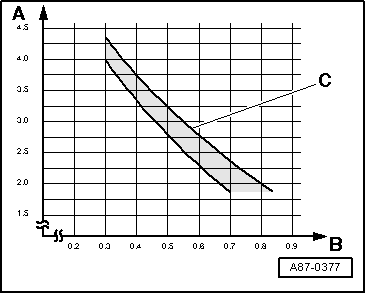Volkswagen Tiguan Service and Repair Manual: Checking with Restrictor, Reservoir and A/C Compressor Regulator Valve -N280-, Externally Regulated A/C Compressor
Note
- Connecting service station.
- Observe test requirements.
- Bring engine speed up to 2000 RPM.
- Pay attention to the A/C service station pressure gauge.
Note
Switching pressures for actuation of A/C Compressor Regulator Valve -N280- and Coolant Fan -V7- are vehicle-specific.
Specified Values
High-pressure side:
Increasing from initial pressure (when connecting pressure gauges) to 20 bar (290 psi).
Low-pressure side:
Decreasing from initial pressure (when connecting pressure gauges) to the value in the graph.
- Low pressure (measured at service connection) in bar (psi) absolute
- Control current for A/C Compressor Regulator Valve -N280-.
- Permissible tolerance range

Note
- Under unfavorable conditions (very high ambient temperatures, high humidity), pressure on high-pressure side may increase to max. 29 bar (421 psi).
- The control current -B- is shown in the measured value block.
- The high pressure is shown in the measured value block.
- Low pressure settles as a function of control current for A/C Compressor Regulator Valve -N280- within compressor output range in tolerance range.
- Under unfavorable conditions (very high ambient temperatures, high humidity), compressor output may not always be sufficient to attain the specified value.
- The specified operating current for the regulator valve must be greater than 0.3 A in order to ensure reliable valve activation.
- In the setting "maximum cooling output" control current is regulated to approximately 0.8 A (displayed in measured value block).
- At absolute pressure, 0 bar/psi corresponds to absolute vacuum. Normal ambient pressure corresponds to 1 bar (14.5 psi) absolute pressure. 0 bar/psi pressure corresponds to an absolute pressure of 1 bar (14.5 psi) on most pressure gauges (indicated by 1 bar (14.5 psi) below 0 bar/psi).
| Possible deviation from specification | Possible cause of fault | Corrective action |
|
|
|
|
||
|
Note
If no malfunction is found with this complaint, flush (clean) refrigerant circuit with refrigerant R134a. If that is not possible in this workshop, flush the refrigerant circuit with compressed air and remove moisture with nitrogen.
| Possible deviation from specification | Possible cause of fault | Corrective action |
|
|
|
|
|
|
|
|
|
|
|
|
Note
- For the malfunction "high pressure normal, low pressure too low", note the following: faulty, the evaporator can ice up or the cooling output is not reached.
- With this malfunction, evaporator may ice up although quantity of refrigerant in circuit is OK.
- Check measured values of Evaporator Vent Temperature Sensor -G263- or Evaporator Temperature Sensor -G308-.
- Check the A/C Compressor Regulator Valve -N280- activation.
| Possible deviation from specification | Possible cause of fault | Corrective action |
|
|
|
|
|
|
|
Note
- Overfilling with refrigerant oil can occur if, for example, the compressor has been replaced without adjusting the quantity of refrigerant oil.
- If the A/C compressor is not replaced, the refrigerant oil should be drained from the A/C compressor via the oil drain plug. Out of the entire quantity of refrigerant oil, 50 grams should be put in the A/C compressor and the rest in the refrigerant circuit. Refer to vehicle-specific repair manual.
 Checking with Expansion Valve and Receiver/Dryer, with Internally Regulated
A/C Compressor
Checking with Expansion Valve and Receiver/Dryer, with Internally Regulated
A/C Compressor
Note
Connecting service station.
Observe test requirements.
Bring engine speed up to 2000 RPM.
Observe manometer battery.
Note
Switching pressures and design of refrigerant circuit sw ...
 Checking with Expansion Valve, Receiver/Dryer and A/C Compressor
Regulator Valve -N280-, Externally Regulated A/C Compressor
Checking with Expansion Valve, Receiver/Dryer and A/C Compressor
Regulator Valve -N280-, Externally Regulated A/C Compressor
Specified Values
Note
Connecting service station.
Observe test requirements.
Bring engine speed up to 2000 RPM.
Pay attention to the A/C service station pressure gauge.
Note
High-press ...
See More:
Volkswagen Tiguan Owners Manual > Exterior care and cleaning: Introduction to the subject
In this chapter you will find information on the following subjects:⇒ Washing
the vehicle
⇒ Washing with a power washer ⇒ Cleaning windows and outside mirrors
⇒ Cleaning and changing the windshield wiper blades ⇒ Waxing and polishing vehicle
paint
⇒ Caring for and cle ...
Volkswagen Tiguan Owners Manual
Volkswagen Tiguan Service and Repair Manual
- Body exterior
- Body Interior
- General Paint Information
- Paint
- Brake System
- Suspension, Wheels, Steering
- Wheel and Tire Guide
- Towing Guide
- Wheel and Tire Guide General Information
- Communication
- Electrical Equipment General Information
- Electrical Equipment from 06/2011
- Heating, Ventilation and Air Conditioning
- Refrigerant R134a Servicing
- 6-Speed Manual Transmission 02Q, OBB, and OFB
